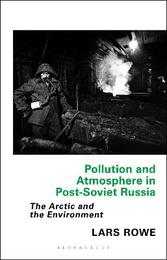
|
Pollution and Atmosphere in Post-Soviet Russia: The Arctic and the Environment
Paperback / softback
Main Details
| Title |
Pollution and Atmosphere in Post-Soviet Russia: The Arctic and the Environment
|
| Authors and Contributors |
By (author) Lars Rowe
|
| Series | Library of Arctic Studies |
|---|
| Physical Properties |
| Format:Paperback / softback | | Pages:256 | | Dimensions(mm): Height 216,Width 138 |
|
| Category/Genre | The Cold war |
|---|
| ISBN/Barcode |
9780755634897
|
| Classifications | Dewey:363.731 |
|---|
| Audience | | Tertiary Education (US: College) | |
|---|
|
Publishing Details |
| Publisher |
Bloomsbury Publishing PLC
|
| Imprint |
Bloomsbury Publishing PLC
|
| Publication Date |
30 June 2022 |
| Publication Country |
United Kingdom
|
Description
This study addresses the many initiatives to decrease industrial pollution emitting from the Pechenganikel plant in the northwestern corner of Russia during the final years of the Soviet Union, and examines the wider implications for the state of pollution control in the Arctic today. By examining the efforts of Soviet industry and government agencies, Finnish and Swedish officials, and Norwegian environmental authorities to curb industrial pollution in the region, this book offers an environmental history of the Arctic as well as a transnational, geopolitical history.
Author Biography
Lars Rowe is Senior Research Fellow at the Fridtjof Nansen Institute and Lecturer in Russian History at the University of Oslo.
ReviewsEnvironmental negotiations with Russians have often been challenging and frequently unsuccessful. In his fine book, Lars Rowe reveals that Russian elites and even the public are not and feel no real reason to be concerned with environmental quality as a top priority. Unless that mindset is understood (or is changed), productive international engagement with Russia will falter. This is an insightful and relevant case study that deserves close attention. * Professor Douglas R. Weiner, University of Arizona, USA * For decades Norwegian and Russian officials sat on opposites of a table - and a border - negotiating how to deal with the dangerous Sulphur and heavy metal pollution of the Pechenganickel Mining and Metallurgical Combine on territory annexed by the USSR from Finland in 1944. Using archival documents, government reports and other sources Rowe considers how commercial, industrial, political and environment disagreements ultimately derailed efforts to modernize the factory and minimize pollution. Rowe covers a broad period - fifty years - and neatly manages to tell the stories of Soviet period developments, the impacts of the Gorbachev reforms, and efforts at environmental safety and security during the Yeltsin and Putin eras. In spite of decades-long negotiations and several bilateral agreements with Norway, as Rowe explains, neither Soviet nor today Russian officials could allow the protection of nature to stand in the way of production. * Professor Paul Josephson, Colby College, USA and Tomsk State University Russia *
|